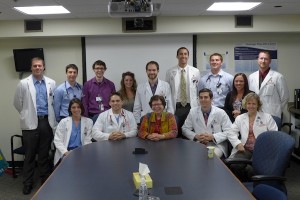I’m continuing my trips around the state to cities with other four-year UW campuses. In my trip this week, I visited Eau Claire and La Crosse, met with editorial boards of the daily newspapers in those towns, and also met with UW–La Crosse Chancellor Joe Gow. (I was supposed to see UW-Eau Claire Chancellor Jim Schmidt, but that ended up not working.) As always, one of my main goals is to meet with our graduates and it was wonderful to hear from the enthusiastic alumni in Eau Claire, at a reception with the Chippewa Valley Chapter of the Wisconsin Alumni Association.
My main message when I talk with alumni and with the press is to make the case for why UW–Madison is a great asset to the state. As I’ve said in other venues, we haven’t done a very good job of telling the citizens of Wisconsin how much the university here in Madison contributes to this state.
While in La Crosse, I had the pleasure of touring Gundersen Health System’s new hospital expansion. In that visit I found an excellent example of the positive impact a major research university like the University of Wisconsin can have in Wisconsin communities.
Gundersen is the Western Academic Campus for our School of Medicine and Public Health. We have similar partnerships with Marshfield Clinic in Marshfield and Aurora Health Care in Milwaukee. That means that our medical students benefit by being able to go to these clinics for training in some of their required rotations through different medical specialties.
A good number of the students who choose Gundersen for their rotations participate in the Wisconsin Academy for Rural Medicine, or WARM, program. This four-year program admits Wisconsin students who intend to practice rural medicine, and has a focus on the particular health challenges faced by rural residents. When these students finish their medical training, they are interested in filling a very important gap in our health care system by serving in rural areas as doctors.
Students told me they received a lot of hands-on training and interaction with patients, and a lot of close instruction from the Gundersen staff. As Dr. David Chestnut, the director of medical education at the hospital, said that he tells the students, “There’s more to learn here than you can learn during the short time that you are here.”
The doctors and administrators I talked to said teaching is an important aspect of their mission at Gundersen. When doctors are recruited to work there, they are told that it is a teaching hospital, and they are expected to be part of that mission.
In an example of how big of an impact the university has on the state, I learned that 68 Gundersen doctors are UW SMPH grads, and they all volunteer time to teach the new students who come through the program.
So the partnership is a win-win for not only the university and our students, who get the advantage of training at a facility consistently ranked among the country’s best, but for Gundersen and the community they serve.
The SMPH-Gundersen partnership is one example of the kind of outreach that many of our schools do in communities across the state. It is the sort of impactful program that we should be touting to everyone who will listen as an example of how UW-Madison makes a difference in Wisconsin.